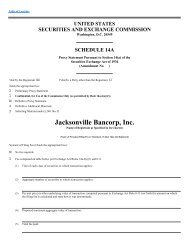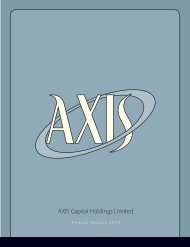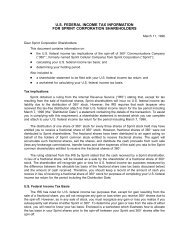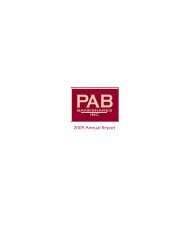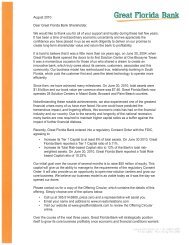Cousins Properties Incorporated 2006 Annual Report - SNL Financial
Cousins Properties Incorporated 2006 Annual Report - SNL Financial
Cousins Properties Incorporated 2006 Annual Report - SNL Financial
Create successful ePaper yourself
Turn your PDF publications into a flip-book with our unique Google optimized e-Paper software.
collectibility of unit purchase prices upon completion. If the Company inaccurately estimates costs to construct the<br />
project, the estimated profit percentage is ultimately incorrect or if its judgments regarding collectibility are<br />
incorrect, actual final results could differ from previously estimated results. See Discussion of New Accounting<br />
Pronouncements below for a new pronouncement affecting future sales recognition for multi-family residential<br />
units.<br />
Valuation of Receivables. Receivables, including straight-line rent receivables, are reported net of an<br />
allowance for doubtful accounts and may be uncollectible in the future. The Company reviews its receivables<br />
regularly for potential collection problems in computing the allowance recorded against its receivables. This review<br />
process requires the Company to make certain judgments regarding collectibility, notwithstanding the fact that<br />
ultimate collections are inherently difficult to predict. A change in the judgments made could result in an<br />
adjustment to the allowance for doubtful accounts with a corresponding effect on net income.<br />
Accounting for Non-Wholly Owned Entities<br />
The Company holds ownership interests in a number of ventures with varying structures. The Company<br />
evaluates all of its partnership interests and other variable interests to determine if the entity is a variable interest<br />
entity (“VIE”), as defined in <strong>Financial</strong> Accounting Standards Board (“FASB”) Interpretation No. 46 R. If the<br />
venture is a VIE and in its judgment the Company is determined to be the primary beneficiary, the Company<br />
consolidates the assets, liabilities and results from operations of the VIE.<br />
For entities that are not determined to be VIEs, the Company evaluates whether or not the Company has<br />
control or significant influence over the joint venture to determine the appropriate consolidation and presentation.<br />
Non-VIEs under the Company’s control are consolidated and non-VIEs in which the Company can exert significant<br />
influence over, but does not control, are accounted for under the equity method of accounting.<br />
The Company recognizes minority interest on its Consolidated Balance Sheets for non-wholly owned entities<br />
which the Company consolidates. The minority partner’s share of current operations is reflected in Minority<br />
Interest in Income of Consolidated Subsidiaries on the Consolidated Statements of Income.<br />
Contributions to unconsolidated joint ventures are recorded as Investments in Unconsolidated Joint Ventures,<br />
and subsequently adjusted for income from unconsolidated joint ventures and cash contributions and distributions.<br />
Any difference between the carrying amount of these investments on the Company’s balance sheet and the<br />
underlying equity in net assets on the joint venture’s balance sheet is amortized as an adjustment to income from<br />
unconsolidated joint ventures over the life of the related asset. If the Company’s judgment as to the existence of a<br />
VIE, the primary beneficiary of the VIE, and the extent of influence and control over a non-VIE is incorrect, the<br />
presentation of the balance sheet and results of operations could be incorrect.<br />
Discussion of New Accounting Pronouncements<br />
In June <strong>2006</strong>, the FASB issued Interpretation No. 48, “Accounting for Income Tax Uncertainties” (“FIN 48”).<br />
FIN 48 defines the threshold for recognizing tax return positions in the financial statements as those which are<br />
“more-likely-than-not” to be sustained upon examination by the taxing authority. FIN 48 also provides guidance on<br />
derecognition, measurement and classification of income tax uncertainties, along with any related interest and<br />
penalties, accounting for income tax uncertainties in interim periods and the level of disclosures associated with any<br />
recorded income tax uncertainties. FIN 48 is effective January 1, 2007 for the Company. The Company does not<br />
anticipate the effect of adopting the provisions of FIN 48 will be material to its financial position or results of<br />
operations.<br />
In November <strong>2006</strong>, the FASB ratified the consensus in Emerging Issues Task Force (“EITF”) Issue No. 06-08,<br />
“Applicability of the Assessment of a Buyer’s Continuing Investment under FASB Statement No. 66, Accounting for<br />
Sales of Real Estate, for Sales of Condominiums,” which provides guidance for determining the adequacy of a<br />
buyer’s continuing investment and the appropriate profit recognition in the sale of individual units in a condominium<br />
project. This issue requires that companies evaluate the adequacy of a buyer’s continuing investment in<br />
recognizing condominium revenues on the percentage of completion method by applying paragraph 12 of<br />
SFAS No. 66 to the level and timing of deposits received on contracts for condominium sales. This rule is<br />
40





